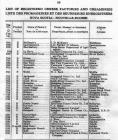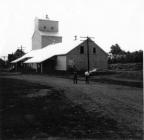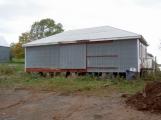1
Alexander Ross and his brother had moved to Tatamagouche from Western Canada where Alex had operated a creamery and milk pasteurizing plant. In 1924, Alex bought land from a Mr. Bonnyman, who had a window and door factory close to the banks of the tidal Waugh River. Probably as a result of encouragement from the Government Agricultural Department, Alex built a creamery on the property and by 1925 the creamery was in production. The operation expanded quickly and by 1929 the Creamery at Tatamagouche was the third largest creamery producing butter in the province of Nova Scotia. Although usually recognised as opening for business in 1925 , some records show that as early as 1924, there were 237 patrons supplying 52,885 lbs of cream which produced 19,027 lbs of butter at a value of $6659.452
Cheese Factories and Creameries in Nova Scotia Publication List20th century
The Tatamagouche Creamery, Creamery Road, Tatamagouche, Nova Scotia, Canada
 Credits:
Credits:North Shore Archives
3
In 1930, the Creamery was purchased by John James 'J.J.' Creighton. Born in Pictou County in 1892, J.J. was educated at Pictou Academy, and then went on to Dalhousie University, Ontario Agricultural College and Guelph Dairy School. His career started as manager of the Baddeck Creamery, and he went on to become Inspector of Creameries for the Nova Scotia Department of Agriculture from 1925 to 1930 after which he purchased the Creamery at Tatamagouche.4
The Tatamagouche Creamery before the renovation in 194320th century
The Tatamagouche Creamery, Creamery Road, Tatamagouche, Nova Scotia, Canada
 Credits:
Credits:Unknown
North Shore Archives
5
Creighton and his wife Irene moved with their family toTatamagouche and he became an influential and well respected member of the community. J.J. was a strong supporter of the Sharon United Church and was Superintendant of the Sunday school for many years and was much loved by staff and pupils. For two terms, 1952 and 1953, he held the position of President of the Dairy Council of Canada. He also played a crucial part in establishing the Tatamagouche Rural High School and Tatamagouche Regional Library. He found time to coach the boy's basketball team, sit on the Colchester Municipal School Board, and help the Lillian Fraser Memorial Hospital, the local Board of Trade, and the Red Cross. J.J. was also an active Liberal supporter and a member of the Village Commissioners.Always willing to assist and encourage the community, J.J. was a generous and kind employer and was greatly admired for all he did. While he owned the Creamery he was prepared to work at all aspects of the business. Indeed all employees were able to turn their hand at anything required of them in the Creamery. Despite long, demanding hours it was a happy environment in which to work.
J.J. had three sons, Austin who worked as a young man at the Creamery before training to be a doctor, Mervyn who went to Acadia University and became a dentist and Ian who was being trained to take over the Creamery, but drowned in a tragic boating accident at the age of 44.
Under Creighton's direction, the Creamery building was enlarged, a large warehouse was built, quantities of flour and feed were bought and later a feed mill was constructed which became an important part of business at the Creamery site.
6
J.J. Creighton, owner of the Tatamagouche Creamery from 1930 - 196720th century
Main Street, Tatamagouche, Nova Scotia, Canada
 Credits:
Credits:North Shore Archives
7
Built in 1958, many local farmers regularly brought grain to the feed mill to be ground into feed for animals. In addition, up to 15 railcars carrying grain from Western Canada came along the rail siding which was adjacent to the mill and running parallel to the main line. The cars would also be separated so that the access road to the Creamery was kept clear for traffic. Once alongside the mill, a hole was cut in the wooden side of the railcar and the grain started to empty. Dale Semple, a former employee, recalls using a kind of shovel with a handle like a baby stroller, attached to a tapering metal shovel with wheels on the back end. This was pushed into the grain, pulled back, turned round and wheeled forward to empty into a hopper on the ground floor.8
Feed mill and the warehouse at the Creamery20th century
The Tatamagouche Creamery, Creamery Road, Tatamagouche, Nova Scotia, Canada
 Credits:
Credits:North Shore Archives
9
'Cups' on an elevator then dipped into the hopper and carried grain up to a distributer on the top floor, where there were four storage containers. The outlets on the distributer could be adjusted to empty into the appropriate grain container. These could in turn be emptied into four large bins on the next floor down, from which the desired grain could be funnelled into sacks.After the railway closed, trucks delivered the grain and it could take a team of men three or four hours to empty a truck, throwing the grain directly into a hopper on the ground floor. When sacks were filled, they were moved across a floor made smoother by the men trampling the lose grain and the dragging of 80 - 100 lb sacks, to a sewing machine which was used to sew the sacks shut. Sacks were then stored in the warehouse to be individually collected or, in the early days, delivered with the cream cans .
10
Sketch showing the interior of the feed mill20th century
The Tatamagouche Creamery, Creamery Road, Tatamagouche, Nova Scotia, Canada
 Credits:
Credits:Jimmy Lefresne
Wayne Mingo
11
The warehouse was built on stilts, as a precaution against rodents. No money was exchanged at the warehouse - people would pay at the Creamery office then go across to where grain and flour were kept and collect their purchases.A second storage building - known as the King's Store. as it was originally part of the King property at the top of Station Road, was moved to the Creamery area, and positioned on the site of the former boiler belonging to the no longer existing Bonnyman Factory Raised on concrete stilts,this housed fertilizer, brewers yeast and grain, for collection by farmers.
Henry Ferguson, a former truck driver for the Creamery, now deceased, became the mill foreman. He said in 1988 that between 1200 and 1500 tons of feed were mixed in a year at the feed mill.
A storage tank for molasses was at one end of the mill, and a machine fed the molasses to the grain mix. Many times the mill was filled to capacity.
During World War 11, much grain was sent to Europe and supplies to Tatamagouche dwindled. When it did arrive, especially supplies of gluten, it sold very quickly and disappointed farmers had another long wait until the next delivery.
12
The King's warehouse20th Century -
The Tatamagouche Creamery, Creamery Road, Tatamagouche, Nova Scotia, Canada
 Credits:
Credits:Jillian Ross
13
J.J. Creighton died in 1967, a much respected employer, and benefactor of Tatamagouche. The year following his death, his wife Irene wrote a sad letter to the Creamery employees and the Creamery was sold to Scotsburn Co-operative Services Limited in 1968.14
Irene Creighton's 'selling' letter written to the employees20th century
Tatamagouche, Nova Scotia, Canada
 Credits:
Credits:North Shore Archives